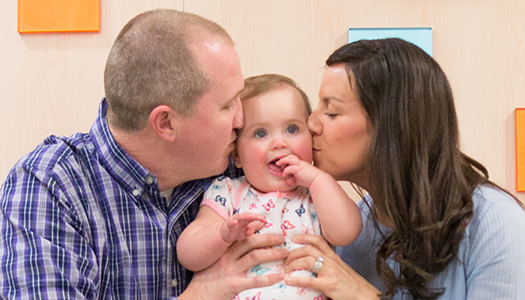Sacrococcygeal teratomas (SCT) are rare tumors that develop near the lower end of an unborn baby’s spine during pregnancy. Moms and babies affected by this complex condition require specialized care throughout pregnancy and after a baby’s birth.
Sometimes, a tumor may cause complications that put the health of mom or an unborn baby at risk. When this happens, doctors may recommend you undergo specialized testing or treatment during pregnancy.
Sacrococcygeal Teratoma: Why Choose Us?
The Women & Infants Center is home to the St. Louis area’s only full-service fetal care center. Patients here are cared for by a team of fetal care specialists, high-risk pregnancy doctors and pediatric specialists from three renowned medical institutions: Barnes-Jewish Hospital, St. Louis Children’s Hospital and Washington University Physicians.

Audra, prenatally diagnosed at 13 weeks with a sacrococcygeal teratoma. Pregnancy care, delivery and postnatal surgery were all coordinated through the Fetal Care Center.
We have extensive experience when it comes to the diagnosis and treatment of SCT. Some of our doctors have been treating this and other rare fetal conditions for more than 30 years.
All of our care is family centered. We use the latest ultrasound technology and a team approach to closely monitor mother and baby after an SCT diagnosis is made before birth. After birth, your baby is cared for by nationally ranked St. Louis Children's pediatric surgeons and other specialists in a level IV Newborn Intensive Care Unit (NICU).
About Sacrococcygeal Teratoma
SCT tumors grow out of the sacral spine (near the bottom of the spine) of an unborn baby. It is the most common type of tumor to develop in unborn babies, affecting an estimated 1 in every 40,000 pregnancies.
There are several types of SCT tumors. The type is based on how much of the tumor grows outside of the baby’s body. Some tumors will grow through the baby’s skin behind the rectum and may appear on an ultrasound as if the baby is sitting on a ball. Treatment ultimately depends on a tumor’s size, location and the amount of blood that flows to the mass. SCT tumors are usually benign (noncancerous).
Cause of Sacrococcygeal Teratoma
Doctors do not know what causes this type of tumor to start growing.
Diagnosing Sacrococcygeal Teratoma
Sacrococcygeal teratomas can affect unborn babies at any point during pregnancy. We use advanced diagnostic ultrasound and fetal ultrafast MRI technology to make a precise diagnosis. If your unborn baby has a SCT, you will meet with a fetal care specialist at your first visit. This specialist will explain what the diagnosis means for you and your baby and answer all of your questions.
Treating Sacrococcygeal Teratoma
Management of a pregnancy affected by SCT is highly individualized. Since these tumors can grow in size, specialized ultrasound technology is used to track the size and location of the SCT to determine if it affects other parts of the baby’s body. As a tumor grows, it may push nearby organs out of the way.
During pregnancy, we may recommend weekly (or more frequent) ultrasounds at our Fetal Care Center. Our sonographers are specially trained in the diagnosis and monitoring of fetal abnormalities, such as SCT. This close prenatal monitoring allows us to see how fast and where a tumor is growing. It also helps us plan for potential complications so we can safeguard the health of you and your baby.
Potential complications include:
- Hydrops: A growing SCT can cause the baby’s heart to work too hard as it tries to pump blood to the tumor as well as the baby’s growing body. In some cases, the baby may develop signs of heart failure, and fluid may collect inside the baby’s body. This is known as hydrops. We work closely with specialists in the Fetal Heart Center to monitor your baby’s heart function using fetal echocardiograms (heart testing).
- Maternal mirror syndrome: This rare and serious condition can occur when a baby becomes hydropic. It causes the mother’s health to mimic that of her sick, unborn child.
- Preterm labor: A growing tumor can also cause an increase in the amount of fluid around an unborn baby inside the womb. This is known as polyhydramnios. A growing SCT combined with increased amniotic fluid can cause the uterus to grow faster than it should. Sometimes this can trick the body into thinking a baby has reached full gestation and cause preterm labor. Preterm labor can cause the baby to be born prematurely.
Complications can be life-threatening for both the mother and the baby. In some cases when a tumor threatens the health of a mother or unborn baby, we may recommend fetal surgery to remove a tumor before your baby is born. We may also recommend a planned preterm delivery.
Our team works together to carefully plan the details of your delivery and protect the health of you and your baby. Most babies with SCT have surgery to remove the tumor shortly after birth. After delivery, all babies affected by SCT receive specialized care in the Women & Infants Center’s level IV newborn intensive care unit (NICU), located less than 100 feet from our delivery room floor in St. Louis Children’s Hospital.
At the Fetal Care Center, we understand the importance of keeping families together. That’s why all of your and your baby’s care happens in one place. Our expert team of newborn, pediatric and maternal-fetal medicine specialists are trained to meet the needs of families facing complex health challenges.
Contact Us
To make an appointment with a Washington University fetal care specialist at the Women & Infants Center, call 866.867.3627.